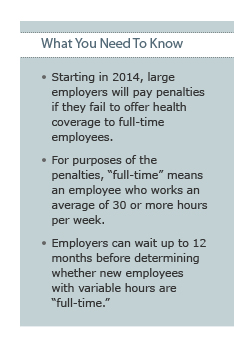Labor and Employment Alert: Guidance on Full-Time Employee Status and Other Employee Benefits News
 The most significant changes under the Patient Protection and Affordable Care Act (ACA) are scheduled to go into effect in 2014. One of those changes is the imposition of shared responsibility penalties on large employers that fail to offer health coverage to all of their full-time employees (or offer health coverage to full-time employees that is deemed to be unaffordable or inadequate). On August 31, 2012, the IRS published Notice 2012-58, providing a safe harbor for the identification of full-time employees for purposes of the shared responsibility penalties.
The most significant changes under the Patient Protection and Affordable Care Act (ACA) are scheduled to go into effect in 2014. One of those changes is the imposition of shared responsibility penalties on large employers that fail to offer health coverage to all of their full-time employees (or offer health coverage to full-time employees that is deemed to be unaffordable or inadequate). On August 31, 2012, the IRS published Notice 2012-58, providing a safe harbor for the identification of full-time employees for purposes of the shared responsibility penalties.
What are the shared responsibility penalties?
Code §4980H will impose two shared responsibility penalties on large employers starting in 2014: the no-offer penalty and the unaffordable/inadequate coverage penalty.
- No-offer penalty. The no-offer penalty applies if a large employer fails to offer all of its full-time employees (and their dependents) group health coverage and at least one full-time employee receives the federal government’s premium assistance to purchase individual health insurance coverage on an exchange. The no-offer penalty equals:
$2,000 X [the number of full-time employees minus 30]
The employee contribution and the employer subsidy for coverage are not relevant to the no-offer penalty (although the IRS is considering separate non-discrimination rules that may make it unfeasible to offer unsubsidized coverage).
A health insurance exchange is supposed to be running in each state starting in 2014. A state that declines to set up an exchange will have an exchange run by the federal government. A dispute is brewing as to whether the federal government may provide premium assistance to individuals purchasing coverage on both state-run and federally run exchanges or just state-run exchanges. Assuming the upcoming election does not change the trajectory of the ACA, the issue may have to be resolved by Congress (by amending the ACA) or the courts.
- Unaffordable/inadequate coverage penalty. The unaffordable/inadequate coverage penalty applies if the health coverage offered by a large employer to its full-time employees is deemed to be unaffordable and/or inadequate and one or more full-time employees receives the federal government’s premium assistance to purchase individual health insurance coverage on an exchange. The unaffordable/inadequate coverage penalty equals the lesser of:
$3,000 X the number of full-time employees receiving premium assistance; or
$2,000 X [the number of full-time employees minus 30].
Who is a large employer?
A relatively small employer may be surprised to find it is classified as a large employer for purposes of the shared responsibility penalties. The shared responsibility penalties generally apply to an employer with 50 or more full-time and full-time equivalent employees in the preceding calendar year. Note that, although part-time employees are included as fractional employees in calculating the large-employer 50-employee threshold, part-time employees are ignored for purposes of determining the actual shared responsibility penalties.
The 50-employee threshold and the no-offer penalty are based on all related companies that are part of the same controlled group. Because the controlled group rules are complicated and the potential penalties are large, it is important to confirm what companies are in your controlled group and what health coverage is offered by those companies.
Who is a full-time employee?
Both the no-offer penalty and the unaffordable/inadequate coverage penalty depend on health coverage available to full-time employees. For this purpose, the ACA defines a full-time employee as an employee who works at least an average of 30 or more hours per week in a month. However, monthly re-determinations of an employee’s status would be burdensome and could lead to frequent (and disruptive) changes in eligibility for health coverage. Neither the government nor insurers want individuals cycling between individual insurance purchased on an exchange (potentially subsidized by federal premium assistance) and employment-based coverage. To minimize changes in eligibility for health coverage, the IRS has proposed a safe-harbor that allows full-time status to be determined on the basis of a retrospective measurement period of up to 12 months and applied during a prospective stability period.
If it is clear at the time of hire that an employee will work full time, the employee must be offered health coverage within 90 days of his or her start date. However, if it cannot be determined at the time of hire that an employee will work full time (a variable hours employee), the employer may determine the employee’s status (full-time or part-time) at the end of a measurement period of up to 12 months. If an employee is determined to be full-time on the basis of the initial measurement period, the employer must make coverage available after an administrative period. The administrative period cannot extend beyond the last day of the first month starting on or after the one-year anniversary of the employee’s start date (i.e., 13 months plus a fractional month).
Variable hour employees include employees who are expected to work 30 or more hours per week during part – but not all – of the measurement period. The Notice states “As one example, a variable hour employee would include a retail worker hired at more than 30 hours per week for the holiday season who is reasonably expected to continue working after the holiday season but is not reasonably expected to work at least 30 hours per week for the portion of the initial measurement period remaining after the holiday season, so that it cannot be determined at the start date that the employee is reasonably expected to average at least 30 hours per week during the initial measurement period.”
The measurement periods are similar to the method of determining initial eligibility for retirement plans on an hours of service basis: there is an initial measurement period tied to the employee’s start date and an overlapping regular measurement period that is the same for all employees in a particular group. Vorys has created a chart summarizing the safe harbors for measurement periods, stability periods and administrative periods (the gap between a measurement period and a stability period). Although the guidance allows for a measurement period that is not the same length as the corresponding stability period, we think that as a practical matter most employers will pick measurement periods and stability periods of identical lengths.
Example: The employer’s standard measurement period is the 12-month period starting October 15 and ending the following October 14 and the employer’s initial measurement period is the 12 month period starting on the date of hire of a new variable hour employee. John, a variable hour employee, is hired May 10, 2014.
If John averages 30 hours per week during 12-month initial measurement period (May 10, 2014 - May 9, 2015), John’s employer must offer coverage starting July 1, 2015, assuming John is still employed on that date.
If John does not average 30 hours per week during the 12-month initial measurement period (May 10, 2014 - May 9, 2015), John’s employer does not have to offer him coverage. However, John’s status must be re-determined based on John’s hours in the standard measurement period (October 15, 2014 - October 14, 2015). Then, if John averages 30 hours per week during the 12-month standard measurement period (October 15, 2014 - October 14, 2015), John’s employer must offer coverage within a standard administrative period not in excess of 90 days (i.e., no later than January 12, 2016), assuming John is still employed on that date. Of course, John’s employer would probably pick a standard administrative period of 79 days so that John’s coverage could start on January 1, 2016.
You can use a measurement period based on calendar months but any days between an employee’s start date and the first day of the next calendar month (the first day of the initial measurement period) count against your administrative period.
You do not have to have the same measurement periods and stability periods for all employees. You can establish different measurement and stability periods for:
1. collectively bargained employees and non-collectively bargained employees;
2. salaried employees and hourly employees;
3. employees of different entities within a controlled group; and/or
4. employees located in different states.
You will need to be able to identify full-time employees starting on January 1, 2014. Therefore, you will want to start applying these rules in 2013. In setting up your measuring system, 130 hours of service in a calendar month is treated as the monthly equivalent of 30 hours of service per week.
The Notice is not comprehensive. The IRS has yet to address how the shared responsibility penalties apply to employers contributing to multiemployer plans or what (if any) coverage must be offered to employees’ dependents in order to avoid penalties. The IRS has asked for comments on the Notice (due September 30, 2012) so we expect some additional guidance before 2014. Also, the guidance on identifying full-time employees is temporary – meaning the IRS may provide different rules for years after 2014.
Other Employee Benefits News
How is the affordability of coverage determined?
For purposes of the unaffordable/inadequate coverage penalty, an employer’s health coverage is deemed to be affordable if the employee contribution divided by the employee’s household income is no more than 9.5%. At least for 2014, an employer will be permitted to use an employee’s Box 1 Form W-2 income in the denominator of the fraction. In other words, the employer’s health coverage will be deemed to be affordable if either:
employee contribution ÷ employee’s household income < 9.5%; or
employee contribution ÷ employee’s Box 1 Form W-2 income < 9.5%.
Although the Box 1 Form W-2 is helpful in projecting the affordability of an employer’s coverage, it does not provide prospective certainty. Box 1 income is impacted by unpaid leaves of absence, 401(k) contributions, and even pre-tax contributions for health coverage and flexible spending accounts.
Another uncertainty is whether the employee contribution – the numerator of the fraction – is the amount the employee must contribute for single coverage or the amount the employee must contribute for family (or, potentially, the tier applicable to the number of individuals in the employee’s family). Although it appears from the explanation of the tax provisions of the ACA by the Congressional Joint Committee on Taxation the affordability is supposed to be measured on the basis of the employee contribution for single coverage, the IRS specifically reserved this issue for guidance.
90-Day Waiting Period
For plan years starting on or after January 1, 2014, the waiting period for group health coverage cannot exceed 90 days. The IRS, DOL and HHS issued temporary guidance on August 31, 2012 addressing the application of this prohibition. In cases where eligibility for an employer’s group plan is limited to full-time employees:
- If an employer cannot reasonably determine whether a newlyhired employee will be full-time, the employer may use an initial measurement period (under the standards applicable to the shared responsibility penalties) to determine the employee’s status (full-time or part-time). The measurement period does not count as a waiting period.
- Periods during which an employee is classified as part-time (under the standards applicable to the shared responsibility penalties) do not count as a waiting period.
- If initial eligibility is based on cumulative hours not in excess of 1,200, the waiting period starts when the employee completes 1,200 hours. This special rule might hint at the government’s strategy for accommodating multiemployer plans.
As with the guidance on the shared responsibility penalties, the guidance on the 90-day waiting period is temporary – meaning the government may provide different rules for years after 2014.
Wellness Programs and the Americans with Disabilities Act
The application of the Americans with Disabilities Act to wellness programs has been a question. The EEOC has not taken an official position on the issue but has implied that any meaningful financial incentive for completing a health risk assessment would constitute an involuntary medical examination in violation of the ADA. In the first case on point to reach the appellate level, the Eleventh Circuit Court of Appeals held that financial incentives given to employees for completing health risk assessments do not violate the ADA. The Court held that the financial incentives were permissible as part of a group health plan’s administration of risks. Seff v. Broward County, No. 11-12217 (11th Cir. Aug. 20, 2012). Of course, one case does not definitively resolve the question and we continue to monitor the issue in the courts.



